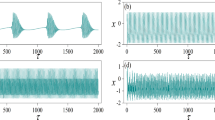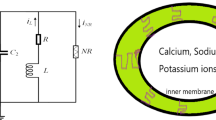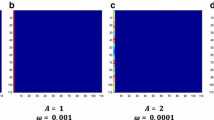Abstract
Static distribution of intracellular and extracellular ions can induce the spatial distribution of electric field in the cell, while stochastic diffusion and propagation of ions can generate channel current accompanied by the magnetic field. In fact, the field energy (including magnetic and electric fields) in each cell or neuron can be changed under external stimuli or the deformation of shape. Furthermore, energy pumping occurs, and the synaptic connection is created adaptively to keep energy balance when more neurons are clustered in the same region because of electromagnetic field superposition. For a synchronous and homogeneous network, all neurons keep energy balance with the adjacent neurons, and the network becomes uniform and identical. For cardiac tissue and biological media, local heterogeneity such as sinoatrial node can emit continuous wave front, and target waves are propagated to regulate the neural activities and heartbeat rhythm. In this paper, the Hamilton energy in a simple neuron model is calculated according to the Helmholtz theorem, and more neurons are clustered to build a regular network (chain network and square array). The creation and growth of synapse connection are controlled to pump energy, and local heterogeneity is formed by taming one intrinsic parameter when more energy is accumulated in a few neurons in the network. These results indicate that asymmetrical energy transport will induce the occurrence of heterogeneity in the network, and adaptive synaptic regulation on neurons is activated to keep local energy balance before reaching perfect synchronization. When external stimuli with diversity in intensity are applied, neurons are excited with energy diversity, and possible shape deformation is induced to keep local energy balance. As a result, heterogeneity is developed in a local area.
Similar content being viewed by others
References
Treibel T A, White S K, Moon J C. Myocardial tissue characterization: Histological and pathophysiological correlation. Curr Cardiovasc Imag Rep, 2014, 7: 9254
Ramadan S, Paul N, Naguib H E. Standardized static and dynamic evaluation of myocardial tissue properties. Biomed Mater, 2017, 12: 025013
Nerheim P, Birger-Botkin S, Piracha L, et al. Heart failure and sudden death in patients with tachycardia-induced cardiomyopathy and recurrent tachycardia. Circulation, 2004, 110: 247–252
Göktepe S, Wong J, Kuhl E. Atrial and ventricular fibrillation: Computational simulation of spiral waves in cardiac tissue. Arch Appl Mech, 2010, 80: 569–580
Cherry E M, Fenton F H. Visualization of spiral and scroll waves in simulated and experimental cardiac tissue. New J Phys, 2008, 10: 125016
Chen J X, Xiao J, Qiao L Y, et al. Dynamics of scroll waves with time-delay propagation in excitable media. Commun Nonlinear Sci Numer Simul, 2018, 59: 331–337
Chen J X, Zhang H, Qiao L Y, et al. Interaction of excitable waves emitted from two defects by pulsed electric fields. Commun Nonlinear Sci Numer Simul, 2018, 54: 202–209
Eason J, Trayanova N. Phase singularities and termination of spiral wave reentry. J Cardiovasc Electrophysiol, 2002, 13: 672–679
Aron M, Herzog S, Parlitz U, et al. Spontaneous termination of chaotic spiral wave dynamics in human cardiac ion channel models. PLoS ONE, 2019, 14: e0221401
Hussaini S, Venkatesan V, Biasci V, et al. Drift and termination of spiral waves in optogenetically modified cardiac tissue at sub-threshold illumination. eLife, 2021, 10: e59954
Sato S. Mathematical properties of responses of a neuron model. Kybernetik, 1972, 11: 208–216
Buchholtz F, Golowasch J, Epstein I R, et al. Mathematical model of an identified stomatogastric ganglion neuron. J Neurophysiol, 1992, 67: 332–340
Knight B W. Dynamics of encoding in neuron populations: Some general mathematical features. Neural Computat, 2000, 12: 473–518
Kaushik A, Sharma M D. Numerical analysis of a mathematical model for propagation of an electrical pulse in a neuron. Numer Methods Partial Differ Eq, 2008, 24: 1055–1079
Popovych S, Gail A, Schropp J. Complex dynamics of a single neuron model. Phys Rev E, 2006, 74: 041914
Mishra D, Yadav A, Ray S, et al. Exploring biological neuron models. Directions, The Research Magazine of IIT Kanpur, 2006, 7: 13–22
Conte E, Pierri G P, Federici A, et al. A model of biological neuron with terminal chaos and quantum-like features. Chaos Solitons Fractals, 2006, 30: 774–780
Fu X, Yu Y. Reliable and efficient processing of sensory information at body temperature by rodent cortical neurons. Nonlinear Dyn, 2019, 98: 215–231
Ditlevsen S, Greenwood P. The Morris-Lecar neuron model embeds a leaky integrate-and-fire model. J Math Biol, 2013, 67: 239–259
Zhu F, Wang R, Aihara K, et al. Energy-efficient firing patterns with sparse bursts in the Chay neuron model. Nonlinear Dyn, 2020, 100: 2657–2672
Song X, Wang H, Chen Y. Autapse-induced firing patterns transitions in the Morris-Lecar neuron model. Nonlinear Dyn, 2019, 96: 2341–2350
Zhao Z, Li L, Gu H, et al. Different dynamics of repetitive neural spiking induced by inhibitory and excitatory autapses near subcritical Hopf bifurcation. Nonlinear Dyn, 2020, 99: 1129–1154
Yue Y, Liu L, Liu Y, et al. Dynamical response, information transition and energy dependence in a neuron model driven by autapse. Non-linear Dyn, 2017, 90: 2893–2902
Wang C, Guo S, Xu Y, et al. Formation of autapse connected to neuron and its biological function. Complexity, 2017, 2017: 5436737
Qu L, Du L, Cao Z, et al. Pattern transition of neuronal networks induced by chemical autapses with random distribution. Chaos Solitons Fractals, 2021, 144: 110646
Yilmaz E, Ozer M, Baysal V, et al. Autapse-induced multiple coherence resonance in single neurons and neuronal networks. Sci Rep, 2016, 6: 30914
Qin H, Wu Y, Wang C, et al. Emitting waves from defects in network with autapses. Commun Nonlinear Sci Numer Simul, 2015, 23: 164–174
Ma J, Song X, Tang J, et al. Wave emitting and propagation induced by autapse in a forward feedback neuronal network. Neurocomputing, 2015, 167: 378–389
Yao C, He Z, Nakano T, et al. Inhibitory-autapse-enhanced signal transmission in neural networks. Nonlinear Dyn, 2019, 97: 1425–1437
Yilmaz E, Baysal V, Perc M, et al. Enhancement of pacemaker induced stochastic resonance by an autapse in a scale-free neuronal network. Sci China Tech Sci, 2016, 59: 364–370
Lin H, Wang C, Deng Q, et al. Review on chaotic dynamics of memristive neuron and neural network. Nonlinear Dyn, 2021, 106: 959–973
Yang R, Huang H M, Guo X. Memristive synapses and neurons for bioinspired computing. Adv Electron Mater, 2019, 5: 1900287
Bao B C, Zhu Y X, Ma J, et al. Memristive neuron model with an adapting synapse and its hardware experiments. Sci China Tech Sci, 2021, 64: 1107–1117
Ignatov M, Ziegler M, Hansen M, et al. A memristive spiking neuron with firing rate coding. Front Neurosci, 2015, 9: 376
Kafraj M S, Parastesh F, Jafari S. Firing patterns of an improved Izhikevich neuron model under the effect of electromagnetic induction and noise. Chaos Solitons Fractals, 2020, 137: 109782
Lu L L, Jia Y, Xu Y, et al. Energy dependence on modes of electric activities of neuron driven by different external mixed signals under electromagnetic induction. Sci China Tech Sci, 2019, 62: 427–440
Yuan Z X, Feng P H, Du M M, et al. Dynamical response of a neuron-astrocyte coupling system under electromagnetic induction and external stimulation. Chin Phys B, 2020, 29: 030504
Zhang Y, Xu Y, Yao Z, et al. A feasible neuron for estimating the magnetic field effect. Nonlinear Dyn, 2020, 102: 1849–1867
Liu Y, Xu W, Ma J, et al. A new photosensitive neuron model and its dynamics. Front Inform Technol Electron Eng, 2020, 21: 1387–1396
Zhang X, Ma J. Wave filtering and firing modes in a light-sensitive neural circuit. J Zhejiang Univ Sci A, 2021, 22: 707–720
Ma X W, Xu Y. Taming the hybrid synapse under energy balance between neurons. Chaos Solitons Fractals, 2022, 159: 112149
Wang C, Sun G, Yang F, et al. Capacitive coupling memristive systems for energy balance. AEU-Int J Electron Commun, 2022, 153: 154280
Zhou P, Zhang X, Ma J. How to wake up the electric synapse coupling between neurons? Nonlinear Dyn, 2022, 108: 1681–1695
Xie Y, Yao Z, Ma J. Phase synchronization and energy balance between neurons. Front Inform Technol Electron Eng, 2022, doi: https://doi.org/10.1631/FITEE.2100563
Kyprianidis I M, Papachristou V, Stouboulos I N, et al. Dynamics of coupled chaotic Bonhoeffer-van der Pol Oscillators. WSEAS Trans Syst, 2012, 11: 516–526
Zhou P, Yao Z, Ma J, et al. A piezoelectric sensing neuron and resonance synchronization between auditory neurons under stimulus. Chaos Solitons Fractals, 2021, 145: 110751
Guo Y, Zhu Z, Wang C, et al. Coupling synchronization between photoelectric neurons by using memristive synapse. Optik, 2020, 218: 164993
Xie Y, Yao Z, Hu X, et al. Enhance sensitivity to illumination and synchronization in light-dependent neurons. Chin Phys B, 2021, 30: 120510
Xie Y, Zhu Z G, Zhang X F, et al. Control of firing mode in nonlinear neuron circuit driven by photocurrent. Acta Phys Sin, 2021, 70: 210502
Zhou P, Hu X, Zhu Z, et al. What is the most suitable Lyapunov function? Chaos Solitons Fractals, 2021, 150: 111154
Wu F, Guo Y, Ma J. Reproduce the biophysical function of chemical synapse by using a memristive synapse. Nonlinear Dyn, 2022, 109: 2063–2084
Wang C, Lv M, Alsaedi A, et al. Synchronization stability and pattern selection in a memristive neuronal network. Chaos, 2017, 27: 113108
Rajagopal K, Jafari S, Karthikeyan A, et al. Effect of magnetic induction on the synchronizability of coupled neuron network. Chaos, 2021, 31: 083115
Ge M, Jia Y, Xu Y, et al. Wave propagation and synchronization induced by chemical autapse in chain Hindmarsh-Rose neural network. Appl Math Computat, 2019, 352: 136–145
Hussain I, Jafari S, Ghosh D, et al. Synchronization and chimeras in a network of photosensitive FitzHugh-Nagumo neurons. Nonlinear Dyn, 2021, 104: 2711–2721
Hussain I, Ghosh D, Jafari S. Chimera states in a thermosensitive FitzHugh-Nagumo neuronal network. Appl Math Computat, 2021, 410: 126461
Tah F A, Tabi C B, Kofane T C. Pattern formation in the Fitzhugh-Nagumo neuron with diffusion relaxation. Chaos Solitons Fractals, 2021, 147: 110974
Yao Z, Wang C. Control the collective behaviors in a functional neural network. Chaos Solitons Fractals, 2021, 152: 111361
Lu L L, Yi M, Liu X Q. Energy-efficient firing modes of chay neuron model in different bursting kinetics. Sci China Tech Sci, 2022, 65: 1661–1674
Yuan Y Y, Yang H, Han F, et al. Traveling chimera states in locally coupled memristive Hindmarsh-Rose neuronal networks and circuit simulation. Sci China Tech Sci, 2022, 65: 1445–1455
Bao H, Hua Z Y, Liu W B, et al. Discrete memristive neuron model and its interspike interval-encoded application in image encryption. Sci China Tech Sci, 2021, 64: 2281–2291
Chen M, Qi J W, Wu H G, et al. Bifurcation analyses and hardware experiments for bursting dynamics in non-autonomous memristive FitzHugh-Nagumo circuit. Sci China Tech Sci, 2020, 63: 1035–1044
Bao H, Chen M, Wu H G, et al. Memristor initial-boosted coexisting plane bifurcations and its extreme multi-stability reconstitution in two-memristor-based dynamical system. Sci China Tech Sci, 2020, 63: 603–613
Li Y Y, Gu H G, Jia B, et al. The nonlinear mechanism for the same responses of neuronal bursting to opposite self-feedback modulations of autapse. Sci China Tech Sci, 2021, 64: 1459–1471
Ge M Y, Wang G W, Jia Y. Influence of the Gaussian colored noise and electromagnetic radiation on the propagation of subthreshold signals in feedforward neural networks. Sci China Tech Sci, 2021, 64: 847–857
Wu S F, Wang L B, Zhao Y W, et al. Chronic electrical stimulation induces functional network changes in cortical neuron cultures. Sci China Tech Sci, 2020, 63: 637–647
Author information
Authors and Affiliations
Corresponding author
Additional information
This work was supported by the National Natural Science Foundation of China (Grant Nos. 12072139, 12062009).
Rights and permissions
About this article
Cite this article
Xie, Y., Yao, Z. & Ma, J. Formation of local heterogeneity under energy collection in neural networks. Sci. China Technol. Sci. 66, 439–455 (2023). https://doi.org/10.1007/s11431-022-2188-2
Received:
Accepted:
Published:
Issue Date:
DOI: https://doi.org/10.1007/s11431-022-2188-2




